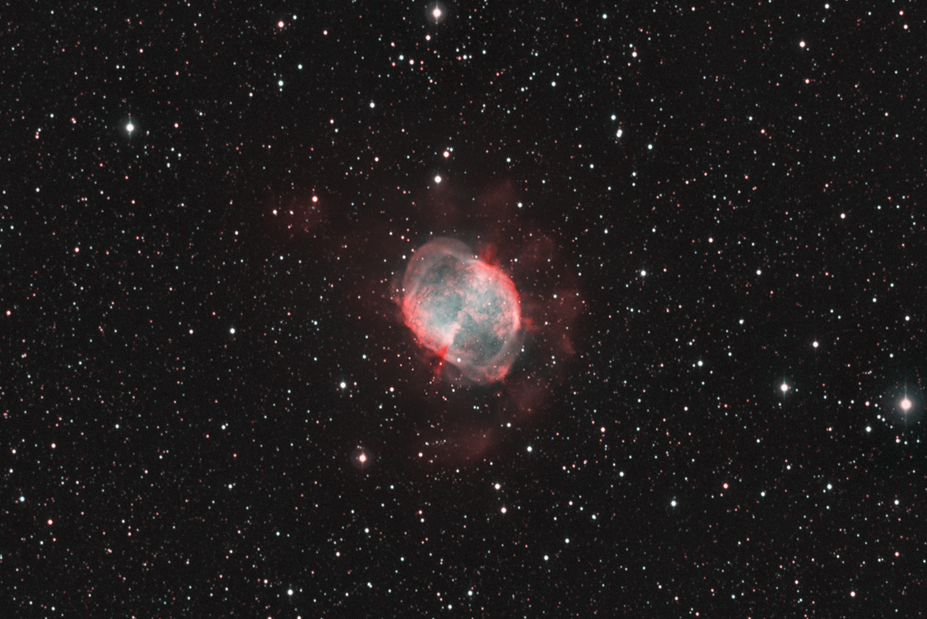M27 (Dumbbell Nebula)
Characteristics:
Magnitude: about 7.3
Size: about 8'
Distance: 1,250 light years
RA: 19h 59m 36s
Dec: 22 degrees 43' 15"
Description:
This is a total 6 hour exposure over 2
nights (3 hours each for Ha and OIII).
The faint Ha skirt was easily detected (click here for Ha
image, and here
for the inverted image), due to the relatively long exposure and the
high Ha sensitivity
of the CM10
camera. This camera has the Kodak KAF3200 microlensed chip and
was ordered without the coverglass (QE curve shown here; original
source document available here).
Although I did not realize it at the time, there is a faint OIII signal
emitted from the skirt as well (click
here for
OIII image), making the color of this peripheral
region more maroon or slightly magenta, as opposed to pure red.
It is also apparent that this peripheral skirt is not homogeneous, but
rather ruffled and scalloped in nature, suggestive of jet-like emission
as opposed to a slowly expanding outward bubble. I am not certain
about this and have submitted this question to others for advice.
Messier
27,
also known as the Dumbbell Nebula, was the 27th object categorized by
Messier during his search for objects that could be confused for
comets.
M27 is a planetary nebula, which represents the end stage of stars
about the
same size as our Sun (in contrast, stars much larger than our Sun
typically undergo a supernova explosion). Such stars experience
a phase of continued helium burning on their surface, long after the
fuel in their core has been exhausted. The outer layer is shed
into space, igniting surrounding elements such as hydrogen through
excitation by the solar wind and heat. The
term "planetary" nebula is a misnomer and was coined by Herschel, based
upon its superficial visual resemblance to his recently discovered
planet, Uranus. More information about M27 may be found here.
Photographic Details:
Date: July 1 and July 2, 2006.
Scope: Takahashi
FS-102 at f6 , on the G11 Losmandy
Mount.
Autoguider: SBIG STV with
e-finder.
Camera: Maxcam CM10
Filter: Astronomik
Ha (6 nm) and OIII (13 nm) filters.
Exposures:
Ha(Ha:OIII:OIII). 18 x 10' Ha (7/1/06); 18 x 10' OIII (7/2/06). Total exposure time 6 hours.
Conditions: Temperature 75 degrees F; intermittent thin
clouds invading the area on both nights.
Post-processing: Debloomed, calibrated,
aligned in Maxim. Combined
using RC Sigma Reject
MaximDL, followed by DDP
in ImagesPlus (IP). Subsequent processing in Photoshop CS (16
bit format). The color image was constructed as
Ha:OIII:OIII. The luminance was provided by the Ha image in order
to enhance detail in the core region Ha(Ha:OIII:OIII).
Please
note: Graphics on this website
may not be reproduced without author permission.
Back to Nebulae
Home
